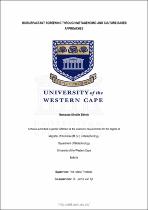| dc.contributor.advisor | Trindade, Marla | |
| dc.contributor.author | Sithole, Nombuso Slindile | |
| dc.date.accessioned | 2023-07-24T14:04:06Z | |
| dc.date.available | 2023-07-24T14:04:06Z | |
| dc.date.issued | 2022 | |
| dc.identifier.uri | http://hdl.handle.net/11394/10412 | |
| dc.description | >Magister Scientiae - MSc | en_US |
| dc.description.abstract | The biosurfactant market is still predominantly represented by the three main products: surfactin, sophorolipids, and rhamnolipids, mainly as a result of the high cost and low yield associated with biosurfactant production. Moreover, only a few novel structures have been discovered in the last decade, due to a lack of interest, low hit rate, and high redundancy, in which the predominant microorganisms producing the same group of biosurfactants are isolated. Hence, there is the obvious need to open up the market with structurally and functionally diverse compounds that have the potential to tailor to specific needs or applications in different industries. | en_US |
| dc.language.iso | en | en_US |
| dc.publisher | University of the Western Cape | en_US |
| dc.subject | Biosurfactant | en_US |
| dc.subject | Culture-based | en_US |
| dc.subject | Culture-independent | en_US |
| dc.subject | Metagenomic | en_US |
| dc.subject | Function-based screening | en_US |
| dc.title | Biosurfactant screening through metagenomic and culture-based approaches | en_US |
| dc.rights.holder | University of the Western Cape | en_US |

